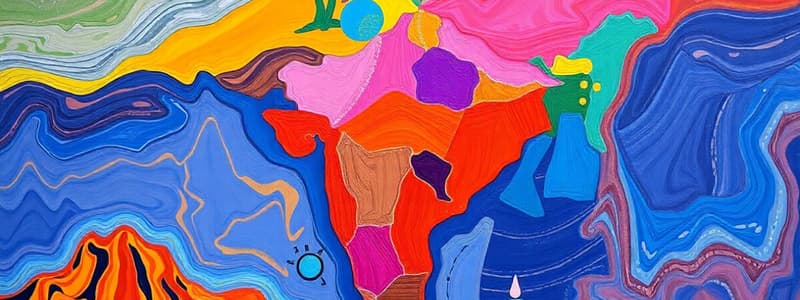Podcast
Questions and Answers
Which region is characterized by rich rice fields and significant cotton and oilseed cultivation?
Which region is characterized by rich rice fields and significant cotton and oilseed cultivation?
- Rift valley region
- Chhattisgarh plain (correct)
- Chota Nagpur plateau
- Rain shadow region
Which river flows through the Rift Valley region?
Which river flows through the Rift Valley region?
- Godavari
- Krishna
- Ganga
- Narmada (correct)
What geological feature primarily defines the Rain Shadow region?
What geological feature primarily defines the Rain Shadow region?
- Flat desert land
- High altitude plains
- Presence of lakes
- Obstruction of rain by mountains (correct)
The Chota Nagpur Plateau is bordered to the north and east by which geographical feature?
The Chota Nagpur Plateau is bordered to the north and east by which geographical feature?
Which of the following minerals is NOT typically found in the Chhattisgarh plain?
Which of the following minerals is NOT typically found in the Chhattisgarh plain?
What type of hills are primarily found in the Peninsular Plateau region?
What type of hills are primarily found in the Peninsular Plateau region?
Which area is known for being a dry region due to its positioning relative to mountain ranges?
Which area is known for being a dry region due to its positioning relative to mountain ranges?
Which of the following does NOT describe the Rift Valley region?
Which of the following does NOT describe the Rift Valley region?
What is the highest peak in the Aravalli Range?
What is the highest peak in the Aravalli Range?
How does the Vindhyan Range primarily differ from the Aravalli Range in terms of geological composition?
How does the Vindhyan Range primarily differ from the Aravalli Range in terms of geological composition?
What is the general elevation range of the Vindhyan Range?
What is the general elevation range of the Vindhyan Range?
Which peak is the highest in the Satpura Range?
Which peak is the highest in the Satpura Range?
The Western Ghats stretch from the Tapti Valley to which geographical landmark?
The Western Ghats stretch from the Tapti Valley to which geographical landmark?
Which range primarily serves as a watershed separating the Ganga system from South India's river systems?
Which range primarily serves as a watershed separating the Ganga system from South India's river systems?
What is a notable characteristic of the Western Ghats regarding its slope?
What is a notable characteristic of the Western Ghats regarding its slope?
How long is the Aravalli Range approximately?
How long is the Aravalli Range approximately?
What is the primary reason Western Ghats Rivers do not form deltas?
What is the primary reason Western Ghats Rivers do not form deltas?
Which geographical feature is primarily formed by Western Ghats Rivers instead of deltas?
Which geographical feature is primarily formed by Western Ghats Rivers instead of deltas?
How does the rocky terrain of the Western Ghats affect sediment transport?
How does the rocky terrain of the Western Ghats affect sediment transport?
What effect does strong wave action in the Arabian Sea have on sediment from Western Ghats Rivers?
What effect does strong wave action in the Arabian Sea have on sediment from Western Ghats Rivers?
What is a characteristic feature of the Eastern Ghats?
What is a characteristic feature of the Eastern Ghats?
Which range includes the tallest peak of the Eastern Ghats?
Which range includes the tallest peak of the Eastern Ghats?
What feature interrupts the hilly character of the Eastern Ghats between the Godavari and the Krishna?
What feature interrupts the hilly character of the Eastern Ghats between the Godavari and the Krishna?
What factor contributes to the limited sediment availability in Western Ghats Rivers?
What factor contributes to the limited sediment availability in Western Ghats Rivers?
What is the average elevation of the Western Ghats?
What is the average elevation of the Western Ghats?
Which notable peak has the highest elevation in southern India?
Which notable peak has the highest elevation in southern India?
What characterizes the middle Sahyadri region?
What characterizes the middle Sahyadri region?
Which gap connects the plains of Tamil Nadu with the coastal plain of Kerala?
Which gap connects the plains of Tamil Nadu with the coastal plain of Kerala?
What is a significant feature of the northern section of the Western Ghats?
What is a significant feature of the northern section of the Western Ghats?
Which of the following peaks is NOT located in the Western Ghats?
Which of the following peaks is NOT located in the Western Ghats?
Which of the following peaks is found in the middle Sahyadri region?
Which of the following peaks is found in the middle Sahyadri region?
What distinguishes the Western Ghats as a UNESCO World Heritage site?
What distinguishes the Western Ghats as a UNESCO World Heritage site?
Flashcards are hidden until you start studying
Study Notes
India's Geographical Regions
- The Rift Valley experiences crustal spreading resulting in deeper erosion
- Major rivers flowing through it include Narmada, Tapti, and Damodar
- The Chhattisgarh Plain is characterized by undulating tracts of land
- Known for rice, cotton, and oilseed cultivation
- Rich in coal, iron ore, bauxite, manganese, and clays
- The Chota Nagpur Plateau spans across Jharkhand, Odisha, West Bengal, Bihar, and Chhattisgarh
- Bordered by the Indo-Gangetic plain to the north and east
- The Mahanadi River basin lies to the south
- Rain Shadow Region refers to dry areas on the leeward side of mountain ranges
- Mountains block rain-producing weather systems
- Example: Eastern side of the Sahyadri ranges encompassing regions like northern Karnataka, Sholapur, Beed, Osmanabad, and Vidarbha
The Hills of the Peninsular Plateau
- Relict Hills are remnants of hills and horsts formed millions of years ago
- Horst refers to an uplifted block of land
- Graben refers to a subsided block of land
- The Aravalli Range stretches 800 km from Delhi to Palanpur (near Ahmedabad)
- Extends in a north-east to south-west direction
- General elevation is 400-600 m with some hills exceeding 1,000 m
- Among the world's oldest fold mountains and the oldest in India
- Extends to Haridwar beneath the Ganga Plains' alluvium
- Some geographers suggest its branches extend to the Lakshadweep Archipelago
- Prominent in Rajasthan, reaching up to 900 m
- Becomes less distinct in Haryana and Delhi, with detached ridges beyond Ajmer
- Mount Abu is a small hilly block separated from the main range by the Banas Valley
- Guru Shikhar (1,722 m), the highest peak of the Aravalli Range, is in Mount Abu
- Pipli Ghat, Dewair, and Desuri passes facilitate road and railway movement
The Vindhyan Range
- Runs parallel to the Narmada Valley in an east-west direction
- Extends from Jobat in Gujarat to Sasaram in Bihar
- Covers over 1,200 km
- Forms a steep escarpment along the northern edge of the Narmada-Son Trough
- Predominantly composed of ancient horizontally bedded sedimentary rocks
- General elevation is 300 to 650 m
- Extends eastward, continuing as the Barner and Kaimur hills
- Serves as a watershed, separating the Ganga system from South India's river systems
- Rivers like Chambal, Betwa, and Ken originate within 30 km of the Narmada
The Satpura Range
- A series of seven mountains running east-west for about 900 km
- Situated south of the Vindhyas
- Located between the Narmada and Tapti rivers
- Dhupgarh (1,350 m) near Pachmarhi on Mahadev Hills is the highest peak
- Amarkantak (1,127 m) is another significant peak
The Western Ghats (or The Sahyadris)
- Forms the western edge of the Deccan tableland
- Rises abruptly from the Western Coastal Plain and slopes gently on its eastern flank
- Stretches for 1,600 km from the Tapti Valley to slightly north of Kanniyakumari
- Steep-sided hills with a stepped topography facing the Arabian Sea coast
- Average elevation of 900-1600 m, increasing from north to south
- Stepped appearance due to horizontally bedded lavas
- A UNESCO World Heritage site
- One of the world's eight 'hottest hotspots' of biological diversity
- Northern Section stretches from the Tapti valley to the north of Goa
- Comprises Deccan lavas (Deccan Traps)
- Average height of 1,200 m
- Notable peaks include Kalasuba, Salher, Mahabaleshwar, and Harishchandragarh
- Thal Ghat and Bhor Ghat passes provide passage between the Konkan Plains and the Deccan Plateau
- The Middle Sahyadri extends from 16°N latitude up to the Nilgiri hills
- Characterized by dense forests
- Western scarp significantly dissected due to headward erosion of streams
- Average height is around 1200 m, with numerous peaks surpassing 1500 m
- Notable peaks include Vavul Mala, Kudremukh, and Pushpagiri
- The Nilgiri Hills abruptly rise to over 2,000 m, joining the Sahyadris near the tri-junction of Karnataka, Kerala, and TN
- This junction marks the convergence of the Western Ghats with the Eastern Ghats
- Important peaks include Doda Betta (2,637 m) and Mukurti (2,554 m)
- The Southern Section separated from the main Sahyadri range by the Palghat Gap (Palakkad Gap)
- The Palghat Gap serves as a rift valley connecting the plains of TN with the coastal plain of Kerala via roads and railway lines
- This gap serves as a passage for southwest monsoon clouds, bringing rain to the Mysore region
- Anai Mudi (2,695 m) is the highest peak in southern India
- From Anai Mudi, three ranges radiate in different directions:
- The Anaimalai (1800-2000 m) to the north
- The Palani (900-1,200 m) to the northeast
- The Cardamom Hills or the Ealaimalai to the south
The Eastern Ghats
- Run parallel to India's east coast
- Often seen as separate units lacking structural unity and continuous physiography
- Average elevation of 600 m
- A chain of fragmented hills extending from the Mahanadi in Odisha to the Vagai in TN
- Exhibit true mountain character in the northern part, between the Mahanadi and the Godavari
- Maliya Range (900-1,200 m): Mahendra Giri is the tallest peak
- Madugula Konda Range (1,100-1,400 m): The tallest peak of the Eastern Ghats, Jindhagada Peak (1690 m), is located here. Other peaks are Arma Konda, Gali Konda, and Sinkram Gutta.
- Between the Godavari and the Krishna, the Eastern Ghats lose their hilly character and are occupied by Gondwana formations
River Systems
- Western Ghats Rivers do not form deltas due to:
- Steep gradient
- Short course
- Limited sediment load
- Strong wave action
- Western Ghats Rivers instead form estuaries at their mouths
Studying That Suits You
Use AI to generate personalized quizzes and flashcards to suit your learning preferences.




